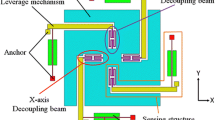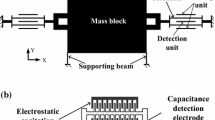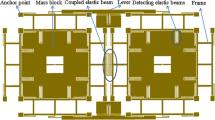Abstract.
Microleverage mechanisms have potentially wide applications in Micro-Electro-Mechanical Systems (MEMS) for achieving mechanical or geometrical advantages. Constrained by micro-fabrication technology, microleverage mechanisms are formed by planar flexures and referred to as compliant mechanisms. In this paper, the analysis and optimization of a single-stage compliant microleverage mechanism is presented, with double-ended tuning fork (DETF) as the output system in a resonant accelerometer to address design issues. It is found that the axial and rotational spring constants of the output system can significantly influence the amplification factor and need to match those of a pivot (with high axial spring constant and low rotational spring constant being desirable) in order to achieve maximum force amplification. This compliance-match theory is very important for the design of both single-stage and multiple-stage microleverage mechanisms.
Similar content being viewed by others
Author information
Authors and Affiliations
Additional information
Received October 14, 1999 Revised manuscript received March 3, 2000
Rights and permissions
About this article
Cite this article
Su, XP., Yang, H. Single-stage microleverage mechanism optimization in a resonant accelerometer . Struct Multidisc Optim 21, 246–252 (2001). https://doi.org/10.1007/s001580050189
Published:
Issue Date:
DOI: https://doi.org/10.1007/s001580050189




